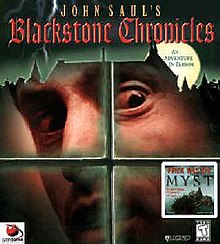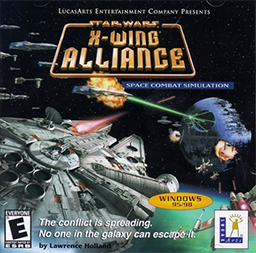
Star Wars: X-Wing Alliance is a 1999 space simulation video game, the sequel to both Star Wars: TIE Fighter and Star Wars: X-Wing vs. TIE Fighter. X-Wing Alliance presents the story of the Azzameen family, a family of space traders. The player assumes the role of Ace Azzameen, the youngest of the Azzameen children, juggling military duty as a fighter pilot for the Rebel Alliance, and allegiance to his family, flying larger heavily armed freighters for the family business, amid a bloody family feud and in the larger context of a galactic civil war. It received favorable reviews.
Legend Entertainment Company was an American developer and publisher of computer games, best known for creating adventure titles throughout the 1990s. The company was founded by Bob Bates and Mike Verdu, both veterans of the interactive fiction studio Infocom that shut down in 1989. Legend's first two games, Spellcasting 101: Sorcerers Get All the Girls and Timequest, had strong sales that sustained the company. Legend also profited from negotiating licenses to popular book series, allowing them to create notable game adaptations such as Companions of Xanth and Gateway. Legend also earned a reputation for comedic adventures, with numerous awards for Eric the Unready in 1993. As the technology of the game industry changed, Legend continued to expand its game engine to take advantage of higher graphical fidelity, mouse support, and the increased media storage of the compact disc.

The Elder Scrolls Adventures: Redguard is an action-adventure video game developed and published by Bethesda Softworks. It is unique in The Elder Scrolls series as the only game with a predetermined character and forced third-person point of view.

MechCommander is a real-time tactics video game based on FASA's BattleTech/MechWarrior franchise, developed by FASA Interactive and distributed by MicroProse in 1998. An expansion pack, Desperate Measures, was released in 1999.
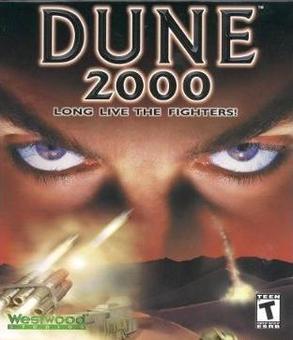
Dune 2000 is a real-time strategy video game, developed by Intelligent Games and published by Westwood Studios in 1998 for Microsoft Windows. It was later ported to the PlayStation in 1999. It is a partial remake of Dune II, which is loosely based on Frank Herbert's Dune universe. The story of the game is similar to Dune II, and is continued in Emperor: Battle for Dune.

Heroes of Might and Magic III: The Restoration of Erathia is a turn-based strategy game developed by Jon Van Caneghem through New World Computing originally released for Microsoft Windows by The 3DO Company in 1999. Its ports to several computer and console systems followed in 1999–2000. It is the third installment of the Heroes of Might and Magic series.
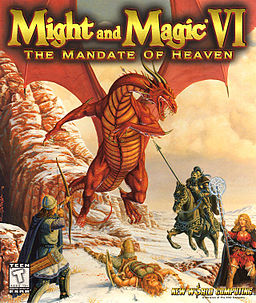
Might and Magic VI: The Mandate of Heaven, commonly abbreviated to Might and Magic VI or simply MM6, is a role-playing video game developed by New World Computing and published by 3DO in 1998. It is the sixth installment in the Might and Magic series, the sequel to Might and Magic V: Darkside of Xeen and the first of the Might and Magic titles to take place on the same planet as Heroes of Might and Magic. It continues the storyline of Heroes of Might and Magic II, and takes place at the same time as Heroes of Might and Magic III in the series chronology. The game was compared favorably to its peers, role-playing video games such as The Elder Scrolls II: Daggerfall. Critics praised it for its non-linear, user-friendly premise, an interactive, detailed game world and a polished, bug-free initial release. A Limited Edition version of the game was also released, including a cloth map of Enroth, a strategy guide and the first five games of the series on CD-ROM. It was followed by three sequels, with Might and Magic VII: For Blood and Honor directly continuing the story arc.

Ian Livingstone's Deathtrap Dungeon is an action-adventure video game developed by Asylum Studios and published by Eidos Interactive for PlayStation and Microsoft Windows in 1998. It is based on the adventure gamebook Deathtrap Dungeon written by Ian Livingstone, and published by Puffin Books in 1984.

FIFA 99 is a football simulation video game developed by EA Canada and published by Electronic Arts under the EA Sports label. It is the sixth game in the FIFA series and was released in 1998 for Microsoft Windows, PlayStation and Nintendo 64.

Magic: The Gathering – Battlegrounds is a real time strategy video game developed by Secret Level, Inc. and published by Atari It is based on Magic: The Gathering collectible card game, with many fundamental differences. The game is based on the creation of heroes and mages that summon forth powerful monsters, spells, and abilities to defeat the enemy duelist. Duelists learn new magical spells by completing the campaign, with more and more spell books becoming available as the player progresses. Each spell is separated into one of 5 colors, each with their own strengths and weaknesses.

Drakan: Order of the Flame is an action-adventure video game developed by Surreal Software and published by Psygnosis in 1999. The game follows Rynn, a young woman with extraordinary martial skills, and an ancient dragon Arokh on their quest to free Rynn's younger brother from the evil sorcerer Navaros. The gameplay alternates between dungeon exploration and hack and slash when Rynn is alone and aerial dogfights when she mounts Arokh. A sequel, Drakan: The Ancients' Gates, was released in 2002.

Sanitarium is a psychological horror point-and-click adventure video game that was originally released for Microsoft Windows. It was developed by DreamForge Intertainment and published by ASC Games in 1998. It was a commercial success, with sales of around 300,000 units. In 2015, it was ported to iOS and Android devices.

Return to Krondor is a role-playing video game set in Raymond Feist's fictional fantasy setting of Midkemia. A sequel to 1993's Betrayal at Krondor, it was released for Windows on the PC in time for the 1998 Thanksgiving and Christmas season. Within the game, the player commands a group of heroes with different attributes, strengths, and weaknesses which the player may upgrade over the course of the game.

The Blackstone Chronicles is a serialized novel by American horror and suspense author John Saul. The series consists of six installments and takes place in a fictional New Hampshire town called Blackstone. The series has been adapted into both a computer game and graphic novel.
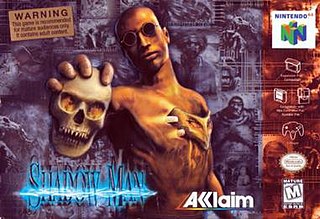
Shadow Man is an action-adventure video game developed by Acclaim Studios Teesside and published by Acclaim Entertainment. It is based on the Shadow Man comic book series published by Valiant Comics. The game was announced in 1997 and was originally slated for a late 1998 release on Nintendo 64 and an early 1999 release for Microsoft Windows, but was delayed to August 31, 1999. A PlayStation version was also released on the same day. A Dreamcast version was released three months later on December 1.

Lands of Lore III is a 1999 action role-playing game developed by Westwood Studios and published by Electronic Arts. It is a sequel to Lands of Lore: Guardians of Destiny and the third game overall in the Lands of Lore video game series. The game set uses a first person perspective with a hack and slash combat system, and it features four "guilds" that the player may join to determine what quests the player will complete. Lands of Lore III was first announced in February 1998, and it received mixed reviews after release.

People's General is a turn-based computer wargame developed by Strategic Simulations, Inc (SSI). It was released in September 1998 in North America and Europe. The game focuses on early 21st century warfare in Asia. People's General, or PeG as it is commonly known, followed SSI's successful 5 Star General Series of World War II war games and their sequel, Panzer General II (PG2). It uses the same game dynamics as these earlier games—turn-based movement & fighting with military units on a hex based map. PeG uses substantially the same "Living Battlefield" game engine as PG2 but features higher quality graphics and many new features.

Army Men is a real-time tactics video game developed and published by The 3DO Company for Microsoft Windows and Game Boy Color.

Montezuma's Return! is a 1997 action/adventure video game and the sequel to the original Parker Brothers game Montezuma's Revenge. While the original game was a 2D platform game, the sequel was a 3D first-person puzzle platformer. According to Steve Bergenholtz, the Utopia Technologies spokesperson, the musical score was written by a TV and film veteran. A port for Nintendo 64 was in the works but was cancelled.

Callahan's Crosstime Saloon is a 1997 graphic adventure game developed by Legend Entertainment and published by Take-Two Interactive. Based on the Callahan's Place book series by author Spider Robinson, the game follows Jake Stonebender, narrator of the books, through six discrete comic science fiction adventures. Taking the role of Jake, the player solves puzzles, converses with characters from the Callahan's Place series and visits locations such as the Amazon rainforest, Transylvania and outer space.
